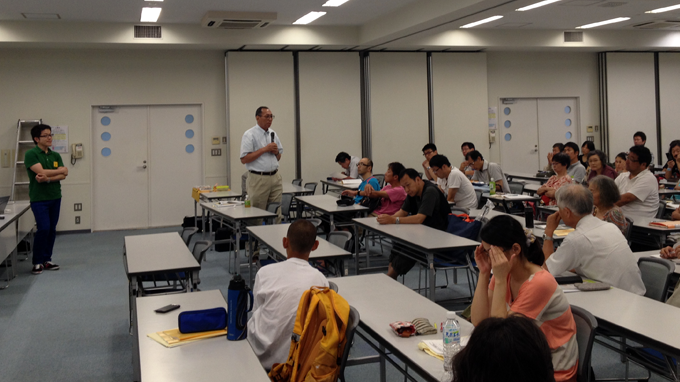The 2014 World Conference against A & H bombs was held in Hiroshima on August 4-6, and in Nagasaki, on August 7-9, to mark the 69th anniversary of the 1945 atomic bombing of the two cities. Six members of our Citizen's Nuclear Information Center (CNIC) took part in this event. Of these, Baku Nishio, Hideyuki Ban, Masako Sawai, and Hajime Matsukubo acted as lecturer or moderator in session meetings in both the Hiroshima and Nagasaki conferences. This is a report on the screening of the movie produced to mark the 60th anniversary of the nuclear test at Bikini Atoll in the Marshall Islands. The film was shown at both conference venues. Sixty years have passed since the hydrogen bomb test Bravo was held at the Bikini Atoll in 1954. We have recently had the opportunity to hold a screening of a film titled Nuclear Savage – The Islands of Secret Project 4.1, directed by Adam Jonas Horowitz, because Adam himself contacted us to ask us if we would show his film in Japan. I was responsible for adding Japanese subtitles to the film. The H-bomb test at the Bikini Atoll is one of the incidents that spurred the movement against A & H bombs. In the wake of the test, the crew of the Japanese tuna fishing boat, the No.5 Fukuryu-maru, was exposed to radiation and the boat's chief radioman Aikichi Kuboyama died on September 23. At that time, people in Japan were alarmed that tuna fish were possibly contaminated with radioactive substances and were too dangerous to eat. Consumers refrained from buying the fish and fishermen were forced to dispose of the unsold fish by burying them in the ground. The film showed some of the nuclear tests in the Marshall Islands, which were carried out 67 times in total, including the Bravo H-bomb test. It also revealed the confidential Project 4.1, in which radiation exposure experiments were conducted on the bodies of the islanders. We are confident that showing this film at the 2014 World Conference against A & H bombs was extremely meaningful. This film proves that the U.S. paid no heed to the human rights of the residents of the Marshall Islands and treated them as something akin to laboratory rats. In the film, an elderly female resident who suffered radiation exposure said very sadly that her first baby had a body that resembled a cluster of grapes and did not look like a human being at all. She also said her second baby looked like a jellyfish, without any bones, and died a few days later. However, her grown-up third child appeared on the screen and said he was healthy, at least up to now. Photojournalist Hiromitsu Toyosaki (c.f. Who’s who 107) gave a talk to explain the contents of the film at the screening. He is an expert on radiation exposure problems, and for more than 25 years has covered the residents of the Marshall Islands and surrounding areas that were irradiated by nuclear weapons tests. He has also studied other people who have been exposed to radiation due to nuclear power generation, uranium mining, and other causes. His Japanese-language book publications on these problems total more than 1,000 pages. While giving his talk, Mr. Toyosaki presented a number of declassified documents regarding Project 4.1 and other related references, which seemed to have been a great help in deepening the audience’s understanding of the film. We plan to hold a screening of the film in Tokyo on November 16, 2014. (Hajime Matsukubo) Return to Radiation Exposure page Return to International Nuclear Cooperation page Return to NIT 162 contents |

| CNIC Citizens' Nuclear Information Center Akebonobashi Co-op 2F-B, 8-5 Sumiyoshi-cho, Shinjuku-ku, Tokyo, 162-0065, Japan TEL.03-3357-3800 FAX.03-3357-3801 Map http://cnic.jp/english/ |

